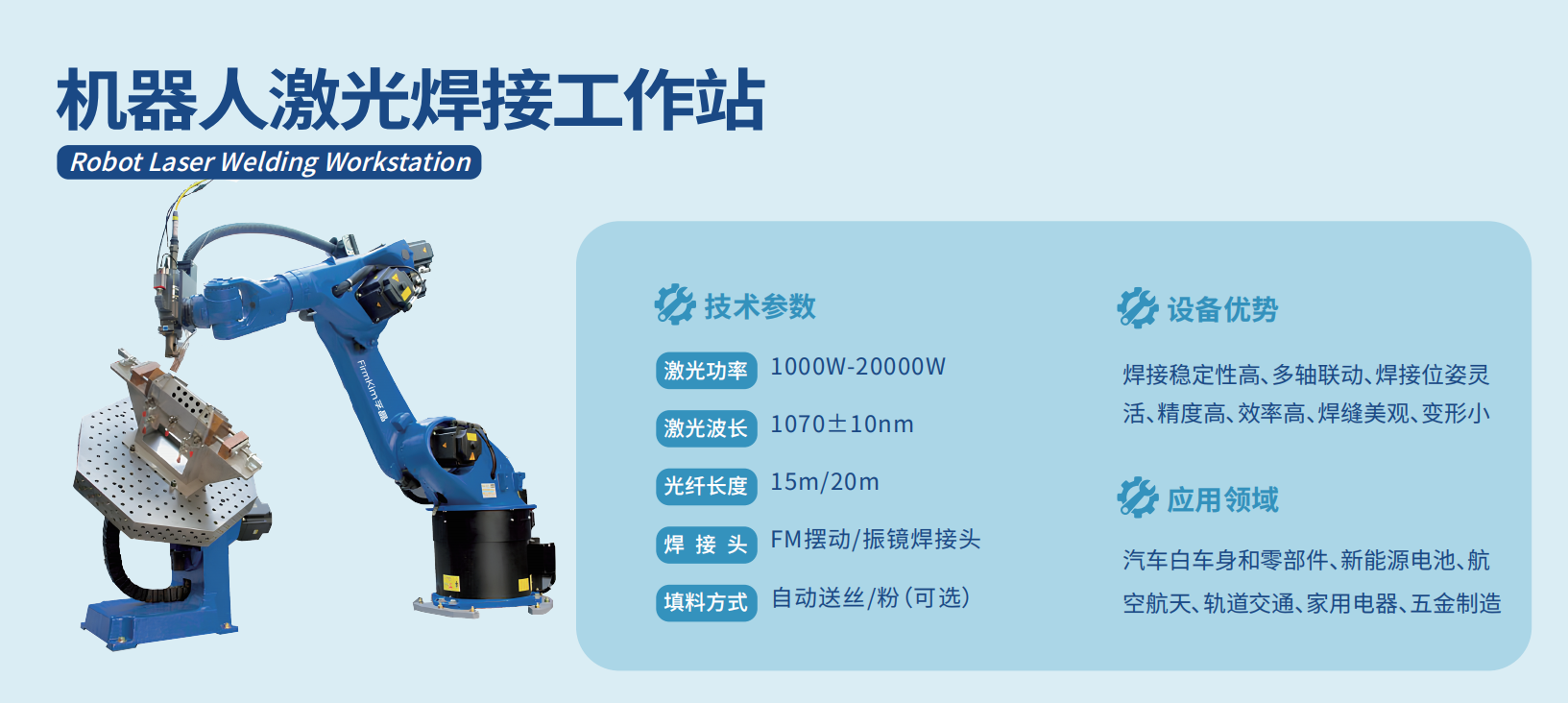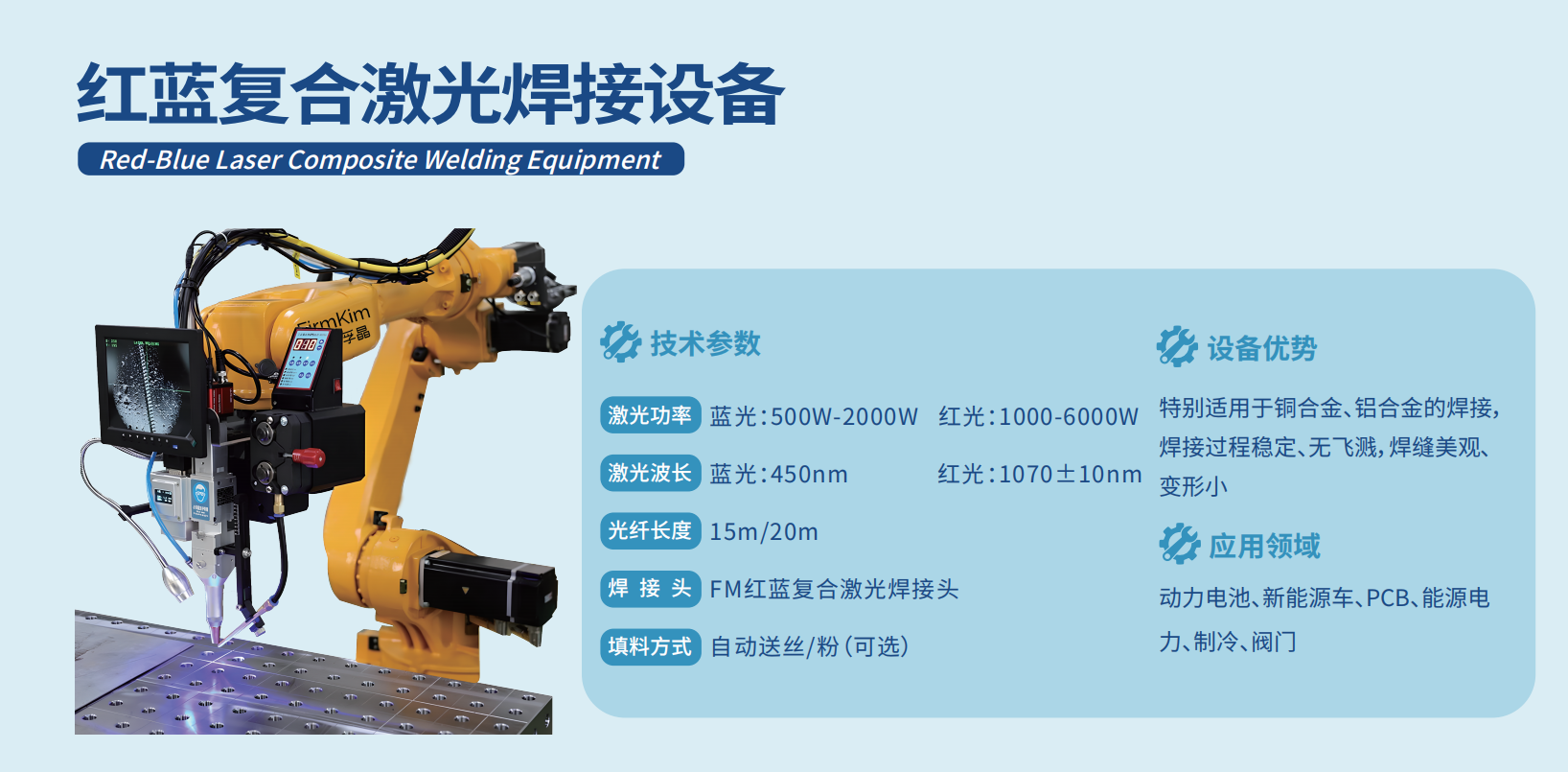Laser welding: an excellent representative of modern welding technology
Release time:
2024-10-23
【Summary Description】 In today's advanced manufacturing field, laser welding has become a high-profile welding technology with its unique advantages and excellent performance. The working principle of 1. laser welding Laser welding is the use of laser radiation energy to achieve effective welding process. The core principle is to excite the laser active medium in a specific way, such as the mixture of CO2 and other gases, YAG yttrium aluminum garnet crystal, etc., so that it oscillates back and forth in the resonant cavity to form a stimulated radiation beam. When the beam is in contact with the workpiece, the workpiece absorbs the laser energy, and the temperature reaches the melting point of the material to start welding. According to the mechanism of welding, laser welding is mainly divided into heat conduction welding and laser deep penetration welding. • Heat conduction welding: laser radiation heating is welded to the metal surface, the surface heat through the heat conduction effect to the material internal diffusion. By precisely controlling the parameters such as the width, energy, peak power and repetition frequency of the laser pulse, the workpiece is melted to form a specific molten pool, and finally the two contact surfaces to be welded are melted and welded together. This welding method is suitable for precision welding of micro, small materials and thin-walled materials. • Laser deep penetration welding: when the laser beam with high power density is radiated to the Welding materials, the material absorbs light energy and converts it into heat energy, which is heated to vaporize to produce metal vapor, and the reaction force generated makes the molten metal liquid flow around and form pits. With the continuous generation of heat, the pit gradually deepens. After the laser irradiation is stopped, the peripheral solution is refluxed and the workpieces are welded together after cooling. This welding method is commonly used for high-speed welding of thick and large materials. Advantages of 2. laser welding • High welding quality: • Weld beautiful: laser welding can achieve non-contact welding, weld smooth, no pores, cracks and other defects, good appearance. • Excellent mechanical properties: laser welding has a molten pool purification effect, which can purify the weld metal, and the mechanical properties of the weld are equivalent to or better than the base metal. Small heat affected zone: laser welding heat input is small, cooling speed and solidification speed is fast, welding heat affected zone is small, microstructure is fine, which is very important for welding heat sensitive materials or parts that need to maintain high precision size. • High welding efficiency: The laser beam can be focused on the welding part quickly and accurately, and the welding speed is fast, which greatly improves the production efficiency. For example, in the automobile manufacturing industry, laser welding has been widely used in the assembly and welding of the car body, which can complete a large number of welding tasks in a short time. High processing flexibility: the laser can be transmitted by optical fiber, the energy loss is very small in the process of transmission, and can be transmitted to a long distance. This allows the laser to be placed at a certain distance from the welding station, which is easy to realize the automation and flexible processing of welding, and can adapt to the welding requirements of various complex shapes and structures. • Wide range of applicable materials: Laser welding can be used for welding carbon steel, low-alloy high-strength steel, stainless steel, aluminum alloy and titanium alloy and other metal materials, and can also be used for welding some non-metallic materials. Disadvantages of 3. laser welding High equipment cost: The price of laser welding equipment is relatively high, including lasers, control systems, optical systems and other parts, and the initial investment is large, which limits the application of some small businesses or low-budget projects to a certain extent. • High requirements for weldments: The position of the weldment must be very precise and must be within the focus of the laser beam. If the weldment requires the use of a fixture, it must be ensured that the final position of the weldment is aligned with the weld spot that the laser beam will impact. • Welding thickness is limited: For thicker workpieces, laser welding may require higher power and longer welding time, and the maximum weldable thickness is also limited. In general, the penetration thickness of the workpiece far more than 19mm, in the production line is not suitable for the use of laser welding. Sensitive to material reflectivity and thermal conductivity: high reflectivity and high thermal conductivity materials such as aluminum, copper and its alloys, weldability is greatly affected by laser wavelength, and it is difficult to achieve thermal conductivity welding. Application fields of 4. laser welding • Automotive manufacturing: The automotive industry is one of the main application areas for laser welding. Laser welding is used for the assembly and welding of automobile body, such as the welding of roof and frame, the welding of door, etc., which can improve the strength and sealing of the body, while reducing welding deformation and weight. In addition, laser welding technology is also widely used in the welding of auto parts, such as engine cylinder gaskets, hydraulic tappets, spark plugs, filters, etc. • Aerospace: In the aerospace field, the requirements for welding quality and accuracy are extremely high. Laser welding can meet these requirements, which is used for the welding of aircraft fuselage structural parts, the welding of engine parts, the welding of rocket engines, etc., which helps to improve the reliability and safety of aircraft. Electronics industry: The manufacture of electronic equipment requires high-precision welding technology. Laser welding can be used for the welding of electronic components, such as the internal circuit connection of mobile phones, computers and other electronic products, chip packaging, etc., to achieve precision welding of small components. • Medical devices: The welding of medical devices needs to ensure the quality and hygiene standards of welding. Laser welding technology can be used in the manufacture of medical devices, such as surgical instruments, dental instruments, medical implants, etc., with the advantages of strong welding and no pollution. • Hardware: Welding of hardware products usually requires high welding strength and aesthetics. Laser welding can be used for the welding of hardware tools, kitchenware, sanitary ware and other products, which can improve the quality and service life of products. In short, as an advanced welding technology, laser welding has the advantages of high welding quality, small heat-affected zone, high efficiency and strong flexibility, and has been widely used in many fields. With the continuous development and improvement of technology, the application range of laser welding will be further expanded and make greater contributions to the development of modern manufacturing.
In today's advanced manufacturing field, laser welding has become a high-profile welding technology with its unique advantages and excellent performance.
The working principle of 1. laser welding
Laser welding is the use of laser radiation energy to achieve effective welding process. The core principle is to excite the laser active medium in a specific way, such as the mixture of CO2 and other gases, YAG yttrium aluminum garnet crystal, etc., so that it oscillates back and forth in the resonant cavity to form a stimulated radiation beam. When the beam is in contact with the workpiece, the workpiece absorbs the laser energy, and the temperature reaches the melting point of the material to start welding. According to the mechanism of welding, laser welding is mainly divided into heat conduction welding and laser deep penetration welding.
• Heat conduction welding: laser radiation heating is welded to the metal surface, the surface heat through the heat conduction effect to the material internal diffusion. By precisely controlling the parameters such as the width, energy, peak power and repetition frequency of the laser pulse, the workpiece is melted to form a specific molten pool, and finally the two contact surfaces to be welded are melted and welded together. This welding method is suitable for precision welding of micro, small materials and thin-walled materials.
• Laser deep penetration welding: when the laser beam with high power density is radiated to the Welding materials, the material absorbs light energy and converts it into heat energy, which is heated to vaporize to produce metal vapor, and the reaction force generated makes the molten metal liquid flow around and form pits. With the continuous generation of heat, the pit gradually deepens. After the laser irradiation is stopped, the peripheral solution is refluxed and the workpieces are welded together after cooling. This welding method is commonly used for high-speed welding of thick and large materials.

Advantages of 2. laser welding
• High welding quality:
• Weld beautiful: laser welding can achieve non-contact welding, weld smooth, no pores, cracks and other defects, good appearance.
• Excellent mechanical properties: laser welding has a molten pool purification effect, which can purify the weld metal, and the mechanical properties of the weld are equivalent to or better than the base metal.
Small heat affected zone: laser welding heat input is small, cooling speed and solidification speed is fast, welding heat affected zone is small, microstructure is fine, which is very important for welding heat sensitive materials or parts that need to maintain high precision size.
• High welding efficiency: The laser beam can be focused on the welding part quickly and accurately, and the welding speed is fast, which greatly improves the production efficiency. For example, in the automobile manufacturing industry, laser welding has been widely used in the assembly and welding of the car body, which can complete a large number of welding tasks in a short time.
High processing flexibility: the laser can be transmitted by optical fiber, the energy loss is very small in the process of transmission, and can be transmitted to a long distance. This allows the laser to be placed at a certain distance from the welding station, which is easy to realize the automation and flexible processing of welding, and can adapt to the welding requirements of various complex shapes and structures.
• Wide range of applicable materials: Laser welding can be used for welding carbon steel, low-alloy high-strength steel, stainless steel, aluminum alloy and titanium alloy and other metal materials, and can also be used for welding some non-metallic materials.
Disadvantages of 3. laser welding
High equipment cost: The price of laser welding equipment is relatively high, including lasers, control systems, optical systems and other parts, and the initial investment is large, which limits the application of some small businesses or low-budget projects to a certain extent.
• High requirements for weldments: The position of the weldment must be very precise and must be within the focus of the laser beam. If the weldment requires the use of a fixture, it must be ensured that the final position of the weldment is aligned with the weld spot that the laser beam will impact.
• Welding thickness is limited: For thicker workpieces, laser welding may require higher power and longer welding time, and the maximum weldable thickness is also limited. In general, the penetration thickness of the workpiece far more than 19mm, in the production line is not suitable for the use of laser welding.
Sensitive to material reflectivity and thermal conductivity: high reflectivity and high thermal conductivity materials such as aluminum, copper and its alloys, weldability is greatly affected by laser wavelength, and it is difficult to achieve thermal conductivity welding.

Application fields of 4. laser welding
• Automotive manufacturing: The automotive industry is one of the main application areas for laser welding. Laser welding is used for the assembly and welding of automobile body, such as the welding of roof and frame, the welding of door, etc., which can improve the strength and sealing of the body, while reducing welding deformation and weight. In addition, laser welding technology is also widely used in the welding of auto parts, such as engine cylinder gaskets, hydraulic tappets, spark plugs, filters, etc.
• Aerospace: In the aerospace field, the requirements for welding quality and accuracy are extremely high. Laser welding can meet these requirements, which is used for the welding of aircraft fuselage structural parts, the welding of engine parts, the welding of rocket engines, etc., which helps to improve the reliability and safety of aircraft.
Electronics industry: The manufacture of electronic equipment requires high-precision welding technology. Laser welding can be used for the welding of electronic components, such as the internal circuit connection of mobile phones, computers and other electronic products, chip packaging, etc., to achieve precision welding of small components.
• Medical devices: The welding of medical devices needs to ensure the quality and hygiene standards of welding. Laser welding technology can be used in the manufacture of medical devices, such as surgical instruments, dental instruments, medical implants, etc., with the advantages of strong welding and no pollution.
• Hardware: Welding of hardware products usually requires high welding strength and aesthetics. Laser welding can be used for the welding of hardware tools, kitchenware, sanitary ware and other products, which can improve the quality and service life of products.
In short, as an advanced welding technology, laser welding has the advantages of high welding quality, small heat-affected zone, high efficiency and strong flexibility, and has been widely used in many fields. With the continuous development and improvement of technology, the application range of laser welding will be further expanded and make greater contributions to the development of modern manufacturing.
Previous Page
Related News






